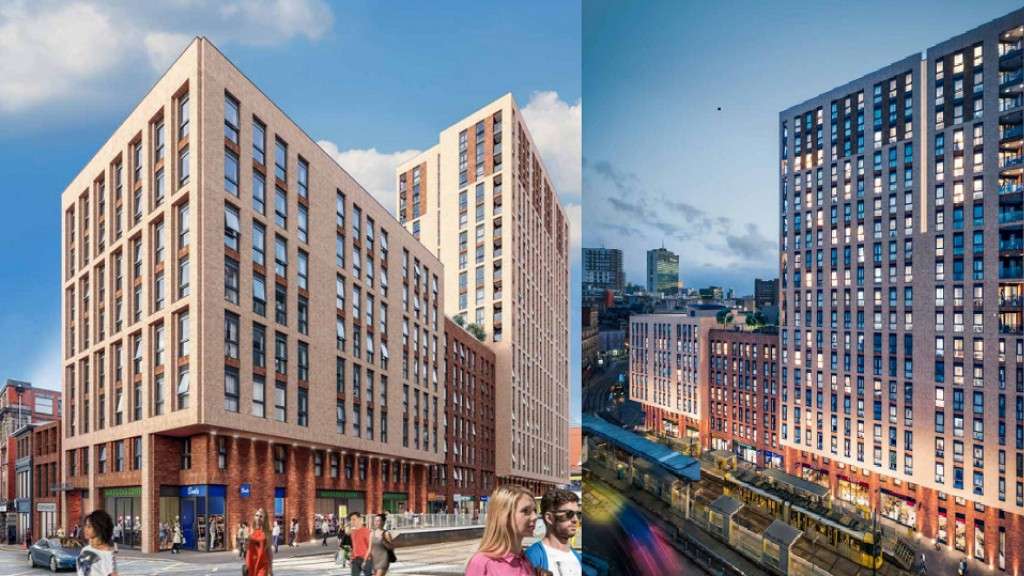PRESS RELEASE: SAVE backs calls to rescue threatened warehouses in central Manchester
Retaining the precious character of this historic and atmospheric quarter is key to successful regeneration
20th October 2023
SAVE Britain’s Heritage will give a statement at a major planning inquiry into plans to demolish a series of 19th century warehouses at Shudehill in Manchester’s Northern Quarter.
The proposals by developer Interland Holdings Ltd for a new high-rise tower block of up to 19 storeys were refused by Manchester City Council in April 2023 on heritage and design grounds, but the developer appealed the decision. The plans are now the subject of a two-week long inquiry opening on 24th October.
SAVE raised concerns about the scheme back in April 2019, in particular the proposed demolition of four fine unlisted Victorian warehouses between Shudehill and Dantzic Street, and the partial demolition of the grade II listed 29 Shudehill.
We also objected to the radically larger scale and overwhelming massing of the new tower block of 175 flats proposed, all within the supposedly protected Shudehill Conservation Area.
Manchester City Council is set to robustly defend its decision to refuse the scheme, focusing on the harmful impact of the demolition of the Victorian warehouses within the Conservation Area, the design of the tower block and doubts over the deliverability of the scheme as a whole.
SAVE will be making its statement on the opening day of the inquiry this Tuesday 24th October 2023 at Manchester Central Convention Complex.
Henrietta Billings, director of SAVE Britain’s Heritage, said: "SAVE is pleased to support Manchester City Council’s robust case against this massive tower and slab scheme. The site’s Conservation Area location and historic warehouses offer a unique opportunity to regenerate this area with a high quality proposal for new development that works with the existing buildings instead of demolishing them. The current scheme is wrong footed – and should be rightly thrown out of any Conservation Area.”
Ben Dewfield-Oakley, conservation officer at SAVE Britain's Heritage, said: "This tower scheme is simply the wrong approach for this site. Shudehill is deeply linked to Manchester's industrial growth since the 18th and 19th centuries and the existing warehouses are good buildings, worthy of retention and reuse. The Conservation Area is designated to protect buildings like them, and the proposed scheme would make a mockery of this protection. The proposals were rightly refused by the City Council, and we are calling on the Planning Inspectorate to uphold that democratic decision."
The developers behind the proposals claim that the massive scale and height of the scheme is necessary to make it profitable and that it takes its design cue from the nearby Glassworks tower, rather than the scale and character of existing buildings in the conservation area. The Glassworks tower is the only tall building in the immediate vicinity and is deliberately excluded from the Conservation Area along with other tall buildings further to the north on Hanover Street.
The Shudehill Conservation Area, designated in 1987, is characterised by a series of low to mid rise warehouse and commercial buildings set close together on sharply angled streets creating interesting views slicing through the blocks. The smaller scale and greater number of narrow-fronted buildings along Shudehill provide a welcome counterpoint to the larger 20th and 21st century buildings to the north and west.
Background
The proposed scheme involves the partial demolition of the grade II listed warehouse building at 29 Shudehill, with the surviving portion left dwarfed by the new 19 storey high rise development behind it. The warehouse, dating from 1810, is noted as contributing to the character of the conservation area with a distinctive stucco facade incorporating unusual full width first floor windows with thin cast-iron columns.
Three other Victorian warehouses at 12 & 14, 16 & 18 Thorniley Brow would also be bulldozed under the scheme, with no consideration given to reusing the buildings. Whilst parts of the application site were lost to Second World War bombing, these surviving warehouses are an important testament to the character and historic development of the area, once bustling with a rich mix of businesses and activity at the heart of Manchester's fabric industry.
The final building on the site is the Rosenfield Building, a former department store located at 18-20 Dantzic Street. The attractive building would be gutted, with only the façade retained as the "footstool" of the tower block behind it. The Rosenfield Building stands alongside the grade II listed Victoria Buildings (6-16 Dantzig Street) which has been handsomely converted for apartments.
SAVE’s recent report Boom not Bust - How Greater Manchester can build the future without destroying its past states: "The benefit of the protection of architectural heritage is that it provides identity to a place, the unique set of buildings and their groupings which tell its story." Nowhere could this be better illustrated than in this surviving corner of the Northern Quarter which risks replacing the defining historic character of the City with faceless glass and slab blocks.
ENDS
Notes to Editors:
1. Boom not Bust - How Greater Manchester can build the future without destroying its past is available HERE
2. For more information contact Elizabeth Hopkirk at SAVE Britain’s Heritage – elizabeth.hopkirk@savebritainsheritage.org / 020 7253 3500
3. SAVE Britain’s Heritage is an independent voice in conservation that fights for threatened historic buildings and sustainable reuses. We stand apart from other organisations by bringing together architects, engineers, planners and investors to offer viable alternative proposals. Where necessary, and with expert advice, we take legal action to prevent major and needless losses

![View towards the application site with the grade II listed 29 Shudehill [© Mark Watson]](/img/articles/MW_23.jpg)
![The Rosenfield Building at 18-20 Dantzic Street would be gutted under the scheme [© Mark Watson]](/img/articles/MW_1.jpg)

![Historic detailing from the rear façade of the Rosenfield Building [© Mark Watson]](/img/articles/MW_17.jpg)